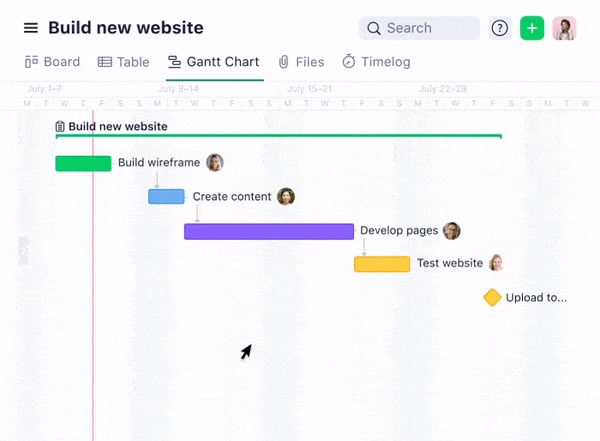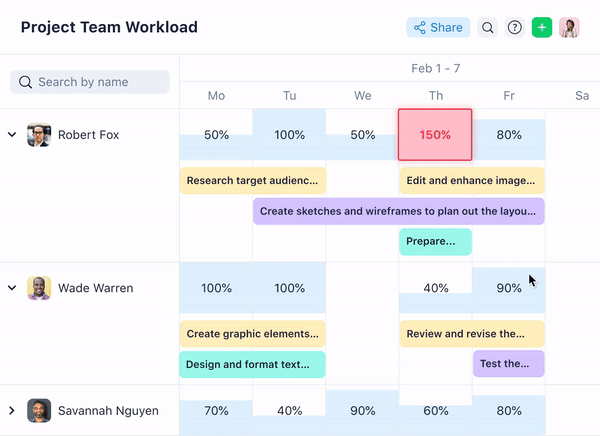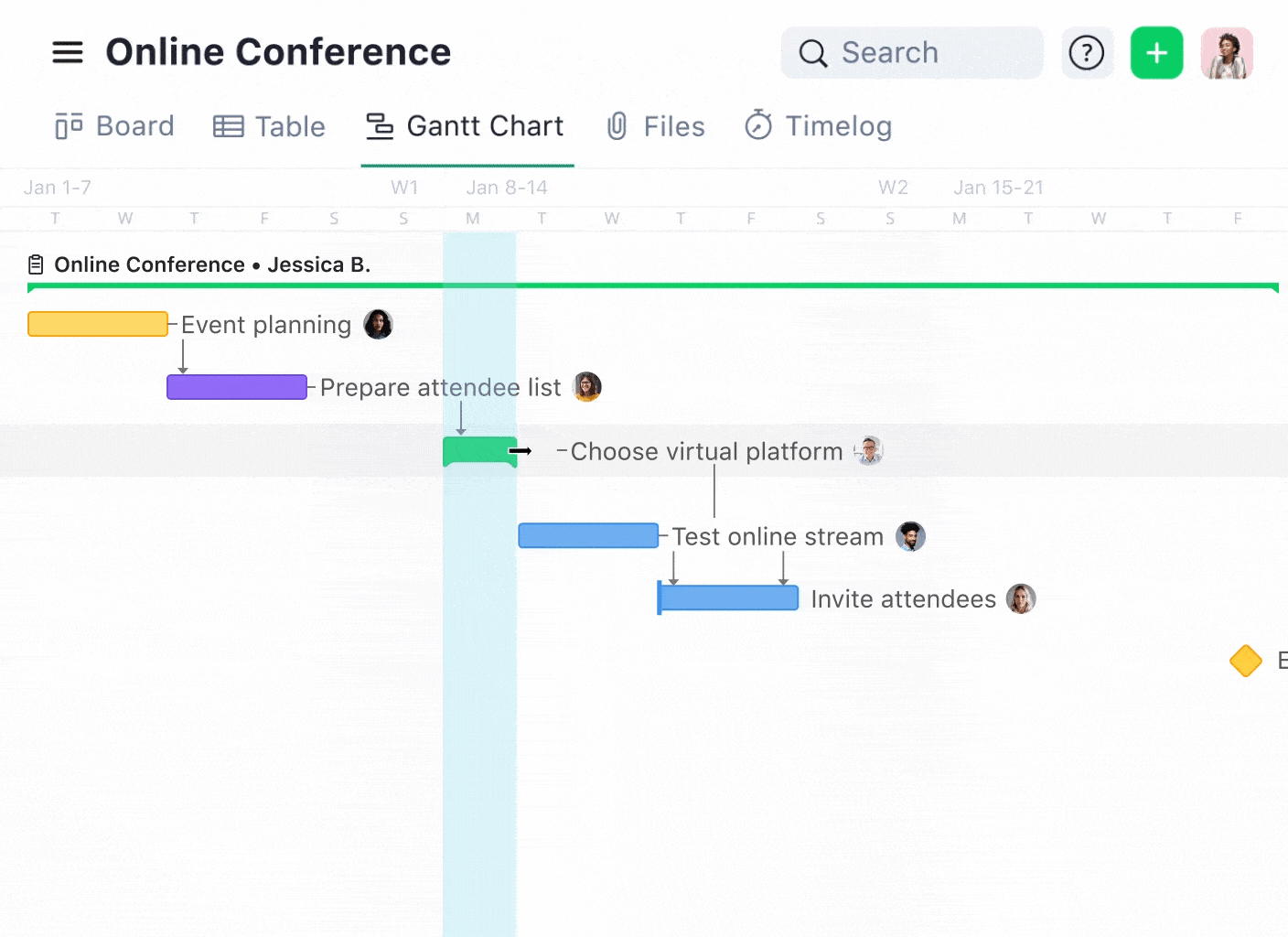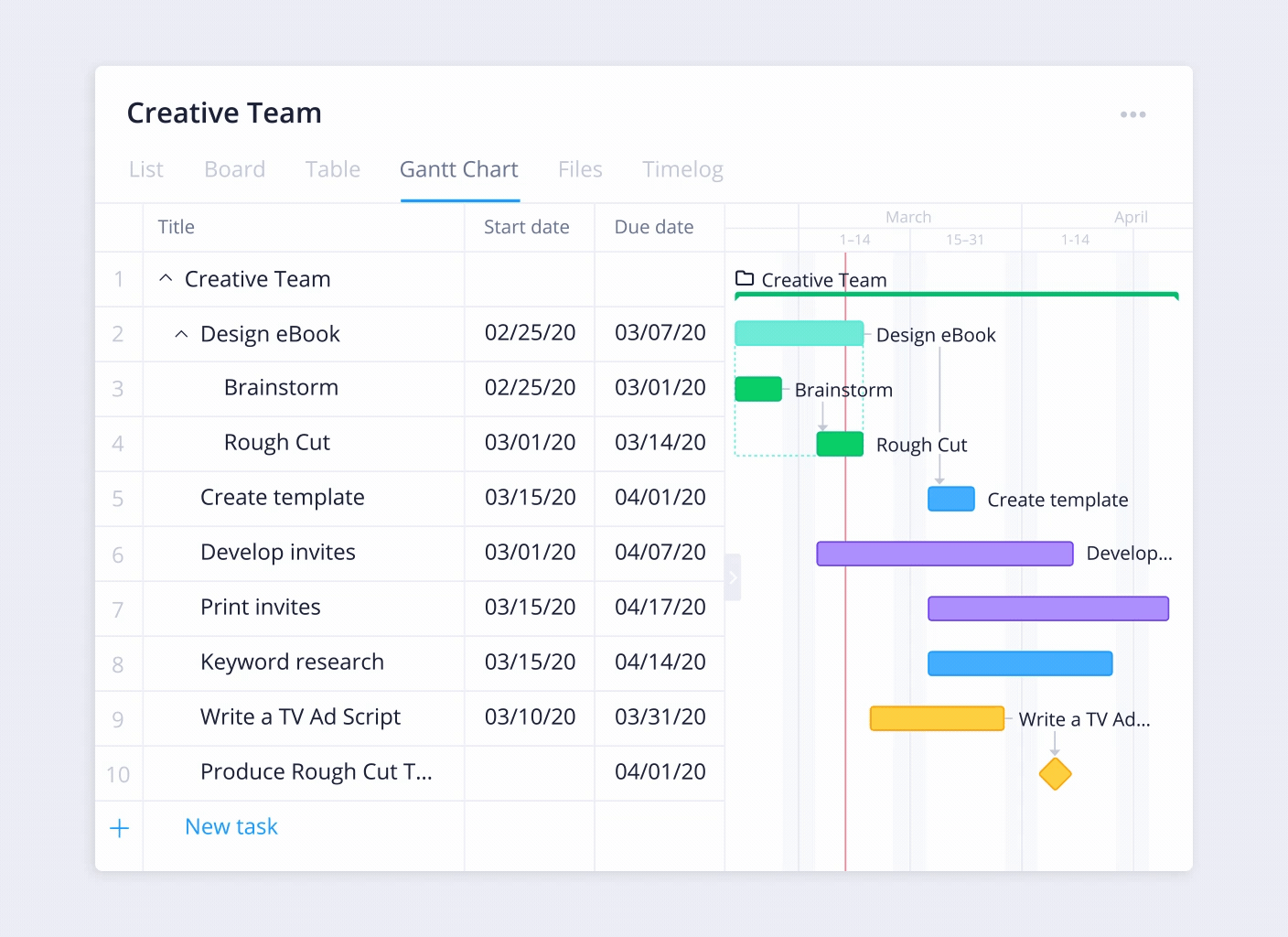Gantt charts, also known as harmonograms, have revolutionized project management with their visual bar chart representation of project timelines in a bar chart format.
The concept was first developed by Polish engineer Karol Adamiecki in the late 1800s, but it was popularized by Henry Gantt in 1915 to help track manufacturing schedules. During World War 1, the Gantt chart became widely adopted, forever cementing its name in project management vernacular.
Back in the day, these charts were drawn on paper and had to be redrawn every time a project shifted. Fortunately, technology has enabled project managers to adjust online Gantt charts with a few clicks within their project management tool. In this article, we’ll show you the top benefits your team can expect from viewing all your projects in a single view.
Top 4 ways to use a single Gantt chart for multiple projects
1. Get visibility on overlapping tasks by setting dependencies
You hear it around the office — people are “juggling a lot of balls.” What many of these folks don’t realize is that they’re juggling blindfolded. When team members handle many projects at once without the right tools, those metaphorical balls are bound to come raining down.
Teams need tools that grant them a full view of everything in the air and help them prioritize which task they need to get their hands on before it hits the floor. That’s where a Gantt chart comes in.
When you have multiple projects going at once, it’s hard to visualize and prioritize tasks. The biggest advantage of using a single Gantt chart while managing multiple projects is that you get to zoom out and see how all your tasks piece together like a puzzle.
Understanding critical information, such as task order and due dates, helps you prioritize, but sometimes you need to be able to see it to digest it fully.
Task order
Some tasks need to come before others. For example, a blog outline would typically be written before creating a draft. But that’s pretty straightforward. If you have a large cartoon video project, what comes first — the voiceover or the visuals?
Both can be pretty big projects on their own and are dependent on one another. As you plan, online Gantt charts empower you to make these decisions and set dependencies — even across projects — between related tasks, ensuring you have enough time to complete tasks in the proper order.
Dependencies
Once you’ve set your dependencies, you can easily see how tasks overlap and when you need to adjust due dates. With an online Gantt chart, dependent tasks move together, so, when you move one task, the others after it will move too. This gives you the tools you need to ensure no tasks fall through the cracks — and no balls hit the floor.

Rearranging your tasks and deadlines doesn’t have to be complicated. Complete your projects with ease using our Gantt charts.
2. Avoid workload overload and potential bottlenecks
A common pain point of many project managers is limited visibility into projects’ scope and progress and the labor involved (including productive utilization).
Imagine you’re a project manager at a startup, collaborating with the engineering team around multiple upcoming product releases. You’ll need to break down several subtasks for each feature, like researching, brainstorming, coding, building the prototype, and testing. This involves a lot of different people. With this many cooks in the kitchen, one bottleneck will affect every project member’s workload and endanger the project’s timeline.
Without the right tools, it’s challenging for project managers to fully digest the work that needs to be done and make sure they’re assigning the right team members to the right tasks at the right time. Looking at multiple projects through a single Gantt chart view makes it easy for project members to run a critical path analysis (CPA) and figure out if a team member is assigned too many critical tasks across projects.
Critical path analysis
- Lay out your project tasks, set deadlines for them and connect dependencies.
- Determine the critical path by identifying the longest stretch of dependent activities and measuring them from start to finish.
- Discern which tasks have total float or can be delayed without making the project longer.
- This helps you visualize what workloads will look like across multiple projects and assign — or reassign — the right people to the right tasks with a simple drag and drop.
- Understanding where to add a strategic cushion into your timeline means you can be more agile as projects inevitably hit unexpected speed bumps.

There are times when you’ll need to adjust the project workload for your team. Be sure to avoid bottlenecks with our Gantt charts.
3. Spot roadblocks and adjust tasks quickly to keep everyone aligned and on time
Swiss civil engineer Hermann Schürch was definitely onto something. Having a Gantt chart template for construction projects is essential — and it’s an easy example we can all relate to.
Anyone that has any experience with construction knows that delays are guaranteed. Between contractors, suppliers, and trucking companies, communication and collaboration are crucial to keeping everyone aligned. If a supplier is running behind, your contractors need to know, and you need to be able to adjust easily.
It’s not just construction, either. In fact, in our survey, 27% of professional services teams said that keeping projects on time and within budget is their #1 challenge and reason for client churn. On top of that, 97% of teams report projects being delayed to some degree.
When one task is late, it impacts everything. And when you have multiple projects and stakeholders dependent on one another, delays cause huge headaches. With roadblocks inevitable, it’s lucky for us that online Gantt charts make it easy to adjust within a project management tool instead of on paper, as Hermann Schürch and our other Gantt innovators were forced to do.
- You get a bird’s-eye view of the progress of your multiple projects, with color-coded bars showing the current task status.
- When you experience delays or identify bottlenecks, you can see the impact moving tasks around will have on other related, dependent projects across tasks.
- Simple drag-and-drop capabilities take the headache out of reworking tasks to get everything back on schedule.

When delays arise, getting back on schedule is imperative. Simplify your project management with Wrike’s online Gantt charts.
4. Leverage templates for consistency, improved productivity, and repeated success
When most organizations have a 70% project failure rate, you’ll want to find a way to replicate the successful ones. Or, better yet, improve them and your project success rate at the same time.
What’s the issue?
For many teams, project processes are not automated or streamlined. A key symptom of this ailment? If your team is constantly running fire drills and reacting as opposed to being proactive, you have a project management problem.
What’s the solution?
A Gantt chart acts as a single graphical document that provides project owners with top-down and bottom-up clarity around project performance — even across multiple projects.
If you have repeated projects with similar tasks, turn your success into a Gantt chart template. It acts as the skeleton of your project. Using a template ensures you never miss a step and have every dependency prepopulated as you adjust the template to your new timeline.
This consistency helps you start measuring performance and optimizing productivity. It also helps your team become a well-oiled machine that easily gets into a highly collaborative workflow.

Want to accomplish more while doing less work? Get yourself a Gantt chart project template to master best practices.
Ready to supercharge your project management?
A Gantt chart for multiple projects is an extremely valuable asset to have in your project management toolkit. By providing visibility and improving collaboration, a better plan and process can help ensure success for every project.
However, adopting a new process or method can be challenging. To get started with Gantt charts and take advantage of their full potential, check out Wrike’s Gantt chart feature. Wrike offers a powerful and user-friendly platform that makes managing multiple projects a breeze. Give your team the tools they need to succeed and sign up for a free trial of Wrike today.
Check out these articles for more Gantt chart tips and tricks:
- A quick start guide on how to use a Gantt chart for project management: The project management beginner’s guide to Gantt charts
- Save time and optimize with online Gantt charts: How to use a Gantt chart to avoid these project management mistakes
- For online Gantt chart best practices: 4 ways not to use a Gantt chart in project management
- For templates to kick-start your projects: Say goodbye to Gantt charts in Excel with these project management templates
- To compare and contrast calendars and Gantt charts: When to use a project calendar vs. a Gantt chart







